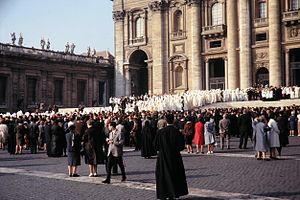 Image via Wikipedia Image via Wikipedia |
| The opening of the second session of the Second Vatican Council |
On 3-5 November I attended, by kind invitation of Professor Joseph Fameree, a conference held at the Catholic University of Louvain-la-Neuve in Belgium on the style of the Second Vatican Council. The issues raised at the conference were of importance not just to Roman Catholics but, ecumenically, to all their ecumenical partners, including, of course, Methodism.
It is well known that the decisions of the Second Vatican Council, in particular the ground-breaking Decree on Ecumenism, allowed the Catholic Church to play a much fuller role within the Ecumenical Movement. In particular, the Decree called for mutual dialogue and learning, allowing Catholics to place a properly appreciative value on the heritage of the other churches, both Orthodox and Protestant and to learn from them.
Like any other documents, the decrees of the Council have been subject to varying interpretations. Catholics have disagreed amongst themselves as to how to see the significance of the Council. Some have stressed the elements of continuity with the pre-Vatican II Church and earlier Councils. Others have argued that the Council represented a more radical break with the past, particularly in the way in which it called on Roman Catholics to engage with the rest of Christendom, the other major faiths and the modern world. Particular decrees addressed these three constituencies and, in particular, the Decree Gaudium et Spes (Joy and Hope) addressed the way in which the Church must approach the modern world, both learning from secular developments yet also examining them in the light of gospel and kingdom values.
A prominent American Catholic scholar, John O’Malley, has argued for the importance of the style of the Council documents in interpreting them. He argues that their positive and encouraging tone contrasted with that of many earlier councils which were far more concerned with condemning errors. He argues that whereas in earlier Catholic theology the stress had been on the hierarchy of the Church (pope and bishops) and on teaching authority, now the stress was on the significance of the whole people of God, including a positive role for the laity and on dialogue with the rest of the world.
It was essentially to evaluate this concept of style that the three catholic universities of Quebec (Universite Laval), Paris (the Institut Catholique) and Louvain organised a research programme and conference, papers being given by members of all three faculties. Particular attention was given to the question of the extent to which the spirit of the Council, not just the details within the particular decrees, has been received. Of course in an imperfect world and in a pilgrim Church still finding its providential way, one cannot find perfection, but there was a deep concern amongst many of the members of the conference that the positive spirit of the Council was not always being honoured in contemporary Catholic practice.
There was constant stress on the pastoral nature of the Council. A particularly interesting paper was given by a younger priest, Fr. Dominique Barnerias, who spoke about his own parish in suburban Paris where lay people are now very heavily involved in mission, community service and pastoral support. He stressed that his layfolk saw the church as their affair not the sole responsibility of the priest in charge.
Considerable stress was placed on the style of the language of the documents, a style that moved, in contrast with the past, from commandment to invitation, from law to ideal, from threat to persuasion, from monologue to conversation, from exclusion to inclusion. In discussing the Council’s teaching on the call of all to holiness, great emphasis was placed on ‘the joyful pursuit of holiness’, a stress that certainly resonates with the hymns of Charles Wesley on the same subject. Several speakers related this style to what they saw as the very style of Jesus himself in his hospitality and openness to all others.
I was myself a student during the years of Vatican II (1962-5) and I remember how learning about the decrees from Catholic fellow students transformed my understanding of the Roman Catholic Church and made me realise how much we could learn from it. The current international Roman Catholic-Methodist dialogue, due to issue another report in 2011, is a direct result of the inspiration and call of the Council of its invitation to what were then called the separated brethren ‘to search together into the divine mysteries’. Some, both of the excitement and of the good practice then developed, has since evaporated. They need to be recovered and shared for the benefit of the whole Church and its unity. I am grateful to my French Catholic sisters and brothers for reminding us of this.

No comments:
Post a Comment